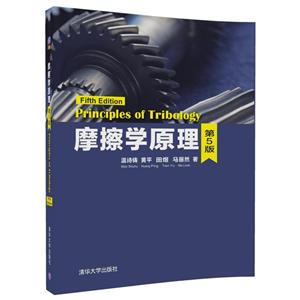-
>
中医基础理论
-
>
高校军事课教程
-
>
毛泽东思想和中国特色社会主义理论体系概论(2021年版)
-
>
中医内科学·全国中医药行业高等教育“十四五”规划教材
-
>
中医诊断学--新世纪第五版
-
>
中药学·全国中医药行业高等教育“十四五”规划教材
-
>
中医外科学——全国中医药行业高等教育“十四五”规划教材
摩擦学原理(第5版)/温诗铸光盘1张 版权信息
- ISBN:9787302500087
- 条形码:9787302500087 ; 978-7-302-50008-7
- 装帧:一般胶版纸
- 册数:暂无
- 重量:暂无
- 所属分类:>>
摩擦学原理(第5版)/温诗铸光盘1张 本书特色
《摩擦学原理(第5版)》反映了摩擦学研究进展以及作者和同事们从事该领域研究的成果,系统地阐述摩擦学的基本原理与应用,全面反映现代摩擦学的研究状况和发展趋势。 全书共22章,由润滑理论与润滑设计、摩擦磨损机理与控制、应用摩擦学等三部分组成。除摩擦学传统内容外,还论述了摩擦学与相关学科交叉而形成的研究领域。本书针对工程实际中各种摩擦学现象,着重阐述在摩擦过程中的变化规律和特征,进而介绍基本理论和分析计算方法以及实验测试技术,并说明它们在工程中的实际应用。 《摩擦学原理(第5版)》可作为机械设计与理论专业的研究生教材和高等院校机械工程各类专业师生的教学参考书,亦可供从事机械设计和研究的工程技术人员参考。
摩擦学原理(第5版)/温诗铸光盘1张 内容简介
《摩擦学原理(第5版)》反映了摩擦学研究进展以及作者和同事们从事该领域研究的成果,系统地阐述摩擦学的基本原理与应用,全面反映现代摩擦学的研究状况和发展趋势。 全书共22章,由润滑理论与润滑设计、摩擦磨损机理与控制、应用摩擦学等三部分组成。除摩擦学传统内容外,还论述了摩擦学与相关学科交叉而形成的研究领域。本书针对工程实际中各种摩擦学现象,着重阐述在摩擦过程中的变化规律和特征,进而介绍基本理论和分析计算方法以及实验测试技术,并说明它们在工程中的实际应用。 《摩擦学原理(第5版)》可作为机械设计与理论专业的研究生教材和高等院校机械工程各类专业师生的教学参考书,亦可供从事机械设计和研究的工程技术人员参考。
摩擦学原理(第5版)/温诗铸光盘1张 目录
- >
【精装绘本】画给孩子的中国神话
【精装绘本】画给孩子的中国神话
¥20.9¥55.0 - >
山海经
山海经
¥22.6¥68.0 - >
诗经-先民的歌唱
诗经-先民的歌唱
¥20.7¥39.8 - >
伊索寓言-世界文学名著典藏-全译本
伊索寓言-世界文学名著典藏-全译本
¥6.1¥19.0 - >
中国人在乌苏里边疆区:历史与人类学概述
中国人在乌苏里边疆区:历史与人类学概述
¥40.8¥48.0 - >
名家带你读鲁迅:故事新编
名家带你读鲁迅:故事新编
¥13.0¥26.0 - >
月亮虎
月亮虎
¥15.4¥48.0 - >
回忆爱玛侬
回忆爱玛侬
¥12.5¥32.8
-
家居设计解剖书
¥27.3¥39 -
网络安全基础
¥27.7¥39.5 -
家具造型设计
¥34.3¥49 -
工程硕士研究生英语基础教程学生用书
¥45.6¥68 -
国外电子与通信教材系列信号与系统(第二版)
¥69.3¥99 -
工程机械维修
¥30.8¥40
超越 卓越
¥28.6¥136.0



















